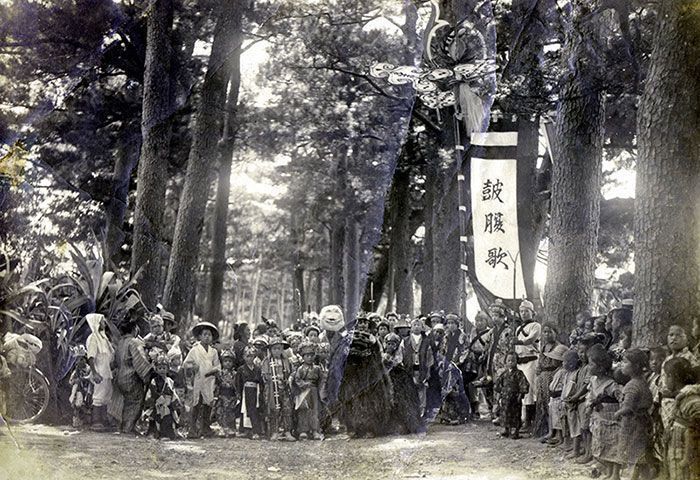Newly discovered photos of Futenma from 1925 provide a clear view of locals as well as pine forest destroyed in the Battle of Okinawa

A photograph showing the “Ginowan Nanmatsu” pine forest in Futenma circa 1925. The photographs shows for the first time examples of local folk culture such as the milk mask, lion dancers, decorative flag, and other attire (photograph provided by Takao Nonomura)
March 18, 2020 Ryukyu Shimpo
By Kazuki Furugen
Recently, 88 pre-war photographs such as the one above, which shows locals gathered on the day of a folk art festival taken in 1925 at the “Ginon Nanmachi,” a national natural monument consisting of a row of pine trees connecting Futuenma in Ginowan, were discovered.
According to the Ginowan museum, pictures of the Futenma pine forest have been previously found, but this is the first time in which the faces of the local can be clearly seen, as well as wearing the folk art attire.
Learning about the existence of pre-war folk art alone makes these pictures incredibly valuable.
The 88 newly discovered photographs span a timeframe of 29 years, from 1916 to right before the Battle of Okinawa in 1945, taken by Takamoto Matsunaga (1892-1965), an agricultural engineer from Kagoshima Prefecture who was staying in Okinawa.
He had left behind an album of pictures taken where he was working in Nago, Futenma, an Oroku (modern-day Naha).
The pictures were given to Naha historian Takao Nonomura from Matsunaga’s second daughter Taeko, who lives in Miyazaki Prefecture.
The photographs of the pine forest were confirmed by ex-Futenma ward chief Masamichi Miyagi, 86, who has lived in Futenma since before the war, and says that the photograph is likely taken at the pre-war Futenma pine forest.
Kenya Heshiki from the Ginowan History Museum indicates, “This is the first photograph from the pre-war era depicting folk art such as the milk mask.”
In pre-war Futenma, there was also a local event that took place once every four-to-five years called the “Futenma Maruashibi,” which took place in 1925.
There is also records of a group dance called “The young Kushi chieftain” performed at that time, and it is possible the people in costume in the photograph participated in the dance.
Heshiki said, “A photograph depicting things such as the milk mask, the flag, and the children’s clothing is valuable. You can feel the enthusiasm for preserving the local festival.”
Nonomura, the recipient of the photographs, commented, “I think this could be useful to the people of each community as a document of each regions local history,” stressing that the photographs should be put to good use in Nago, Futenma, and Oroku (Naha).
(English translation by T&CT and Sam Grieb)
Previous Article:Ginowan citizens complain of 90-decibel national anthem broadcast from MCAS Futenma
Next Article:JTA to suspend 60 flight routes due to reduced demand during coronavirus pandemic
[Similar Articles]
- Photograph of Shuri Castle taken 130 years ago found in Yamagata
- UC Santa Cruz students interview woman from 1952 U.S.-occupied Okinawa photograph
- Former marine displays photographs taken 50 years ago
- Shimabukuro’s photography of 1950’s Henoko sans US base shows changes to his hometown
- Shoji and Akira Yoshimi grow Okinawa pines in Kagoshima for the last 40 years
 Webcam(Kokusai Street)
Webcam(Kokusai Street)


